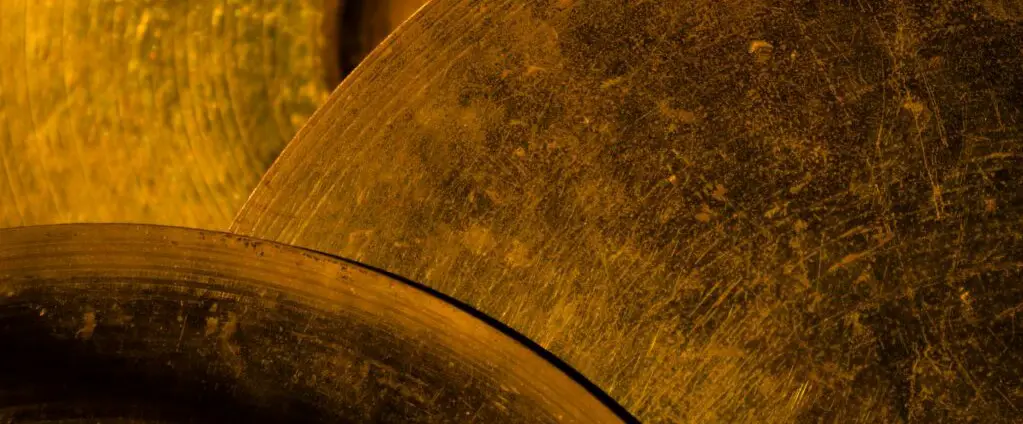It’s not uncommon for older cymbals to turn green and look dull and tarnished, but what causes it and how can it be removed? In this article I’ll explain why this change in appearance occurs and how to both fix and prevent it.
The Quick Answer
Cymbals can turn green over time as they become oxidised which happens when the copper reacts with oxygen to form a green layer known as patina. This can typically be removed using a cymbal polish and the reaction can be slowed down by keeping the cymbals in a cool and dry environment.

Why Do Cymbals Turn Green?
Cymbals are made from a mixture of copper and another metal to make an alloy. Typically the copper is mixed with tin to make bronze.
There are two main types of bronze, B20 and B8, the number refers to the percentage of tin in the alloy. For example, B20 contains 20% tin and 80% copper.
All metals oxidise over time. Oxidation is a chemical reaction which occurs when the metal reacts with oxygen in the air.
For example, when iron oxidises it turns reddish-brown which is referred to as rust. This is because the iron is converted into iron oxide.
Copper on the other hand, turns green when it oxidises, this is commonly referred to as patina.
Patina often takes years to form but the process is accelerated if the cymbals are kept in a more humid environment.
Fun fact: The Statue of Liberty is also made from copper. It was unveiled in 1886 and had a brown, shiny appearance but by 1906 it had turned green as the copper had oxidised to form a patina.

Does Patina Change the Sound of a Cymbal?
The formation of patina on a cymbal which causes it to turn green can make the cymbal sound darker. This is because the high-end (treble) frequencies are reduced causing them to sound more mellow and warmer compared to brand-new, shiny cymbals.
Some players prefer the sound of darker cymbals and will intentionally avoid cleaning and polishing them as they like the sound of an older cymbal.
Cymbals Have a Protective Coating
Since copper is prone to turning green, most cymbals (particularly those which have a polished finish) come with a protective coating to prevent the metal from oxidising and changing color.
However, over time this coating will eventually wear away. This can happen if they are cleaned very frequently or aggressively, or from general wear and tear if the cymbals are a bit older.
How to Clean a Cymbal
As I mentioned in the previous section, more aggressive forms of cleaning/ polishing will cause the protective coating on the cymbal to wear away which means they will turn green more quickly.
If your cymbals have already turned green then this isn’t too much of an issue as the coating has already worn away at this point.
It’s fine to clean all types of cymbals using a microfiber cloth on a regular basis to remove fingerprints and light dust.
You can also use a dedicated cymbal cleaner to give them a more thorough clean. Make sure you choose a cymbal cleaner which is compatible with the finish of your cymbals. Some are designed for natural (unfinished) cymbals and other cleaners are designed for brilliant (polished, shiny) cymbals.
For brilliant finished cymbals you can also use a cymbal polish to give the cymbals a deeper clean and remove any oxidisation. Some polishes will also leave a protective coating to help prevent future oxidisation.
Using household products, citrus or vinegar on cymbals is not recommended as they can damage the finish.
Check out the Zildjian Brilliant Cymbal Polish on Amazon.
Image links to Amazon
How to Prevent Cymbals from Oxidising?
Cymbals will turn green faster if the oxidation process is sped up. The two most common culprits for this are high heat and humidity.
To prevent your cymbals turning green it is advised to store them in a cool, dry place and ideally in a case when not in use. The cymbals should not be exposed to high temperatures or humid conditions so make sure they are not stored near any water.

